What causes a tsunami?... A tsunami is a large ocean wave that is caused by sudden motion on the ocean floor. This sudden motion could be an earthquake, a powerful volcanic eruption, or an underwater landslide. The impact of a large meteorite could also cause a tsunami. Tsunamis travel across the open ocean at great speeds and build into large deadly waves in the shallow water of a shoreline.
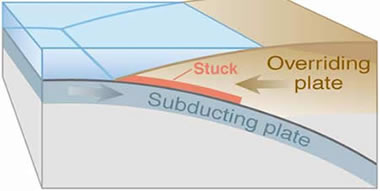
Tsunami generation images by USGS.
Subduction Zones are Potential Tsunami Locations
Most tsunamis are caused by earthquakes generated in a subduction zone, an area where an oceanic plate is being forced down into the mantle by plate tectonic forces. The friction between the subducting plate and the overriding plate is enormous. This friction prevents a slow and steady rate of subduction and instead the two plates become "stuck."
Accumulated Seismic Energy
As the stuck plate continues to descend into the mantle, the motion causes a slow distortion of the overriding plate. The result is an accumulation of energy very similar to the energy stored in a compressed spring. Energy can accumulate in the overriding plate over a long period of time - decades or even centuries.
Earthquake Causes Tsunami
Energy accumulates in the overriding plate until it exceeds the frictional forces between the two stuck plates. When this happens, the overriding plate snaps back into an unrestrained position. This sudden motion is the cause of the tsunami - because it gives an enormous shove to the overlying water. At the same time, inland areas of the overriding plate are suddenly lowered.
Tsunami Races Away From the Epicentre
The moving wave begins travelling out from where the earthquake has occurred. Some of the water travels out and across the ocean basin, and at the same time, water rushes landward to flood the recently lowered shoreline.
Tsunamis Travel Rapidly Across Ocean Basin
Tsunamis travel swiftly across the open ocean. The map on this page shows how a tsunami produced by an earthquake along the coast of Chile in 1960 travelled across the Pacific Ocean, reaching Hawaii in about 15 hours and Japan in less than 24 hours.
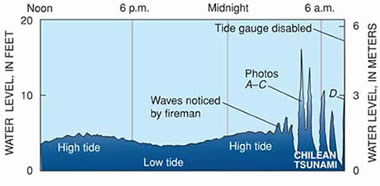
All images shown above are by USGS.
Tsunami "Wave Train"
Many people have the mistaken belief that tsunamis are single waves. They are not. Instead tsunamis are "wave trains" consisting of multiple waves. The chart on this page is a tidal gauge record from Onagawa, Japan beginning at the time of the 1960 Chile earthquake. Time is plotted along the horizontal axis and water level is plotted on the vertical axis. Note the normal rise and fall of the ocean surface, caused by tides, during the early part of this record. Then recorded are a few waves a little larger than normal followed by several much larger waves. In many tsunami events, the shoreline is pounded by repeated large waves.
What causes tsunami?
Most tsunami are caused by large earthquakes on the sea floor when slabs of rock move past each other suddenly, causing the overlying water to move. The resulting waves move away from the source of the earthquake event.
Landslides can happen on the seafloor, just like on land. Areas of the seafloor that are steep and loaded with sediment, such as the edge of the continental slope, are more prone to undersea landslides.
When an undersea landslide occurs (perhaps after a nearby earthquake) a large mass of sand, mud and gravel can move down the slope. This movement will draw the water down and may cause a tsunami that will travel across the ocean.
Tsunami initiated by volcanic eruptions are less common. They occur in several ways:
- destructive collapse of coastal, island and underwater volcanoes which result in massive landslides
- pyroclastic flows, which are dense mixtures of hot blocks, pumice, ash and gas, plunging down volcanic slopes into the ocean and pushing water outwards
- a caldera volcano collapsing after an eruption causing overlying water to drop suddenly.

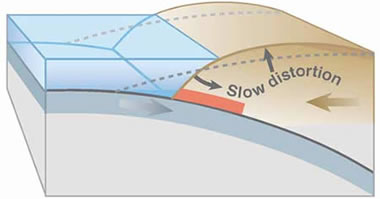
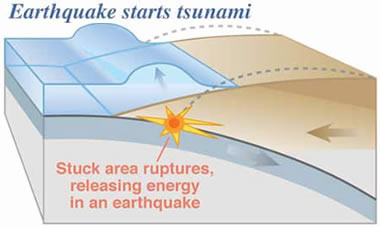
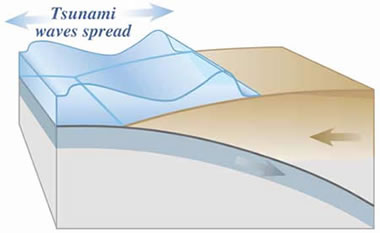
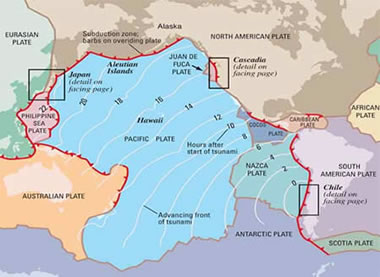


super. Keep it up
ReplyDeleteMy article on tsunami
https://vinganam.blogspot.com/p/tsunami.html